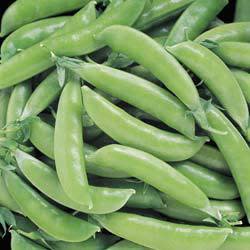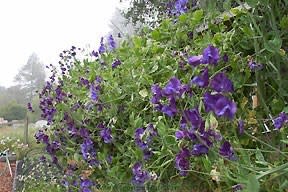Plant Your Peas!

Super Sugar Snap Pea. Image courtesy of Territorial Seed Co.
Peas are a classic spring crop in our region. Not to sound like Ms. Bossy here… but every gardener – beginner or experienced – should grow eating peas! They are so easy, gratifying and so incredibly tasty. I have converted more than one pea-hater into a pea-lover (bad childhood experiences with peas, perhaps?) by giving them bright green, fresh peas from the garden, barely cooked and delicately salted and peppered. Yum! They’re just as fantastic pulled off the vine and eaten fresh, especially the sugar snaps, which are spring’s vegetal candy, as far as I’m concerned.
Consider trying a couple of varieties that are adapted to our local climate. You can usually find a great selection at the seed rack of your local nursery but as the season’s progressing now, you might call ahead to make sure they still have some left. Peas sometimes run out in March. If they’re out, just order them directly from Territorial Seed in Cottage Grove, OR or Nichols Garden Nursery in Albany, OR. Renees Garden is in Felton, CA and Baker Creek Seed in Mansfield, MO also sells good pea varieties, even if these catalogs aren’t geared towards growing in our climate.
Most eating peas are ready to harvest in 55 to 85 days. (Some heirloom varieties take longer.) I always pick an early and a late variety – but if you pick late, and are only starting them now, select an enation-resistant variety and plant it in a spot that will receive afternoon shade by July. Quick-to-harvest varieties that are enation-tolerant or resistant would be best: try Cascadia, Sugar Sprint, and Sugar Star.
Both eating peas and sweet peas come in short varieties and tall vines that can reach over 6 feet. If you don’t want to trellis them or aren’t planting them on a fence, choose petite varieties. But keep in mind, inexpensive bamboo stakes can be easily stuck in the ground to support the larger-growing types which, because they are larger plants, also produce more. I don’t even bother tying them together anymore – the peas clamber all over the stakes and themselves and make an artful tangle of peas.
Both eating peas and sweet peas appreciate rich, well-drained soil rich in phosphorus (the middle number in the fertilizer equation) so apply rock phosphate or bone meal according to package directions. They also appreciate well-composted (not fresh) manure. Add a few shovel-fuls to the planting area and really dig it in. Full sun is best, unless you’re planting late season varieties: peas are cool-season crops and will peter out more quickly if they receive hot afternoon sun in July. In cool summers, peas will sometimes keep flowering and producing through July and into August.

Sweet Pea ‘North Shore’. Image courtesy of Renees Garden Seeds
If you haven’t grown fragrant, lovely flowering sweet peas, give it a shot. They are beautiful little cool-season annual vines, clambering up through a fence or up a sturdy shrub, and providing sheets of deliciously-scented flowers in rich, sometimes strangely attractive colors like blackish-purple, red-flecked white, many lovely pastels and rich jewel tones, and black and blue bicolors. If you like bouquets, pick old-fashioned, fragrant, long-stemmed varieties.
Whether planting eating or flowering sweet peas, you can go low-tech and just plant the peas in the ground, according to the directions on the seed packet. But if you want to get all fancy – and improve flowering and pea-production – buy a packet of legume inoculant. This horrible-smelling black powder is mixed with a bit of water and the seeds are tossed with it to inoculate them for a day or so before sowing. The inoculant packet suggests a few hours of pea-water-seed contact but I have been known to let them soak for a couple of days in a very shallow puddle of inoculant-blackened water, by which time the seeds begin to crack through the skins. When you plant slightly sprouted pea seeds, they emerge quicker. Just be careful to plant quickly – the seeds and inoculant are alive, and must never dry out!
I always use Sluggo non-toxic slug bait along the row, applied when I plant, so that the slug population is low by the time the peas emerge. Slugs can decimate your new baby peas and it can look like the seeds never even sprouted, since the slugs just mow the sprouts down as they emerge.
